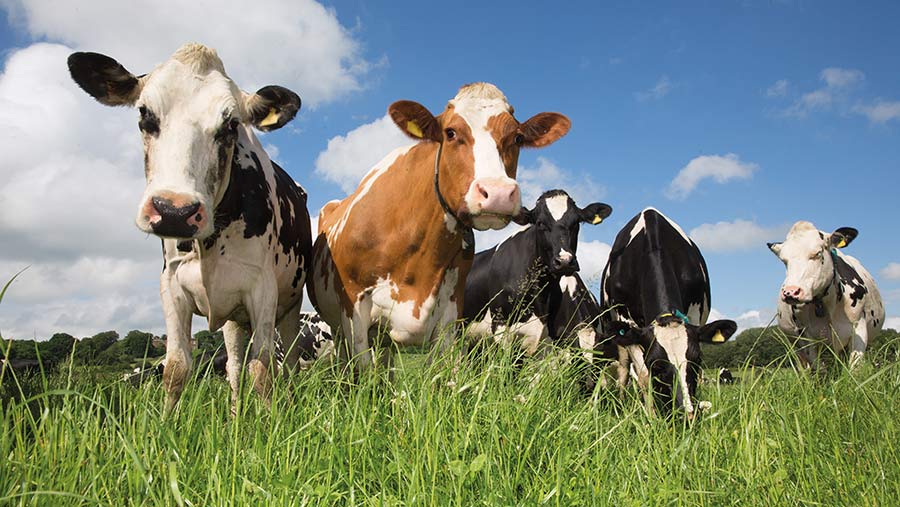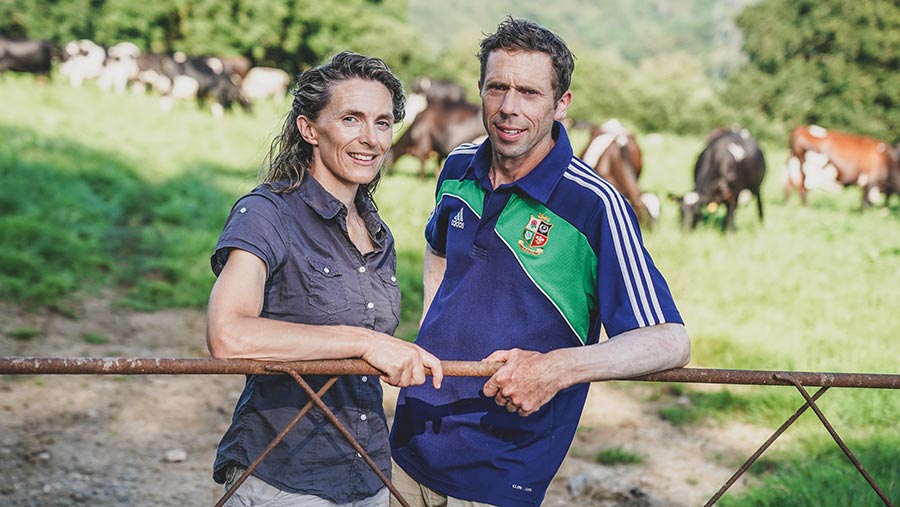Can all-forage dairy diets be practical and profitable?
 © Tim Scrivener
© Tim Scrivener At about 3,250 litres annually, cows fed wholly on forage produce much less milk than dairy herds on diets including concentrates.
But producers who have made the switch say other significant benefits more than make up for it.
“I can hear you thinking, how are we going to make a profit from that?” says Pasture-Fed Livestock Association (PFLA) certification committee member Mike Tame.
“But those animals producing that level of milk are under much less stress than high-yielding dairy cows.”
See also: Farmer gets 14t/ha DM of grass with minimum inputs
Herd comparisons
The PFLA champions farming systems where livestock eat only grass and forage their entire life. Lower input costs more than offset yield losses from grass-based systems, it says.
In 2017-18, the organisation tracked the performance of three PFLA-accredited herds, each with 300 or more cows. It compared the results with typical industry figures for conventional herds.
While milk yields were much lower, so were vet costs, at £17 a year compared with £80 a year. Replacement rates were lower too, at 12% compared with 27%.
And conception to first service for these herds was 85%, compared with about 50% – thought to be due to lower demands on the cows.
Further research by the PFLA put the margin for conventional herds at £1,108 a cow a year, and the Pasture for Life herds at £1,241, says Dr Tame.
As a result of lower yields, and improved fibre digestion because of a more stable rumen pH, milk quality from these herds averaged more than 5% butterfat and more than 4.5% protein.
“So, these cost savings and the improvement in milk quality do compensate for that very much lower milk yield,” he adds.
Making the switch
First-generation dairy farmer Angus Dalton and his family run a spring block-calving herd of 500 Jersey cows on their Staffordshire farm, milking them once a day.
Mr Dalton’s “lightbulb moment” as a conventional dairy farmer came when he heard New Zealand cow nutrition expert John Roche explain that the higher the percentage of grass in the diet, the higher the profitability.
Why the rumen works best when digesting forage
Rumen function is pH-dependent, and the optimum pH for digestion of fibre is around 6.5-6.8. If the pH starts to drop, digestion slows. At 6, it’s significantly slower, and at 5.6 or lower, it effectively stops.
“You don’t want this at all, as fibrous materials are by far the cheapest feed source for ruminants,” says the Pasture-Fed Livestock Association’s Mike Tame.
For animals fed 100% fibre, pH will vary a little, depending on what the animal has eaten, the sugar content of the grasses, and how often it eats, but it will stay around 6.5-6.8 for most of the day.
The situation is very different for a typical total mixed ration for high-yielding dairy cows made up of 20% of the DM from grass silage, 20% DM from maize silage, 35% DM from cereals, and 10% additional carbohydrates from soya, beans or peas, he says.
Within a very short time of eating, the pH will begin to fall, because the rumen micro-organisms will digest the starch very quickly, producing volatile fatty acids such as acetic, propionic and butyric acids.
Dr Tame cites a paper published in Dairy Science where animals on this type of diet had a pH of below 6 for about 11 hours.
“For almost half the day, digestion of fibre was significantly slowed. Worse than that, the pH was below 5.6 for around four hours, when there would be little or no digestion.
“The result of this is relatively poor milk quality, with butterfat of 3.8-4% at best, and protein of 3-3.2%.”
Mr Dalton subsequently reduced concentrate feed intake and put in infrastructure for cows to graze.
“The costs fell away – and not £2,000 here and there, but £80,000-£90,000 year on year,” he said recently at Groundswell. “It was mind-blowing.”
Four years ago, when the farm tenancy was renewed, part of the agreement involved investment in a new parlour.
Concentrate feeders were not installed initially, as they would not be needed until the following spring, but the cows got through without them, convincing the Daltons to switch to a 100% grass-fed system.
What sort of forage?
Some forage types are more digestible than others, according to Dr Tame.
While the nutritional value of ryegrasses is greatest at the three-leaf stage, the decline in digestibility of diverse swards is slower through growing season, he says.
This is because different species reach their peak nutritional value at different points in the season, and because some of them are inherently more digestible.
Diverse swards also:
- Have a higher protein content
- Are more drought tolerant
- Have greater disease resistance
- Have a higher trace mineral content.
Dry matter (DM) intake is also higher.
“Cows work their tongues around what is in front of them, so the denser the sward is, the more they take in,” says Dr Tame.
“Drilled ryegrass swards tend to have quite a space between each plant, so the two swards at the same height will be quite different in terms of plant density.”
Health benefits
The fatty acid profile of milk varies with diet, season, management and breed, says Hannah Davis, lecturer in ruminant nutrition and pasture management at Newcastle University.
Her research found higher levels of omega-3 fatty acids and a better ratio of omega-3 to omega-6 fatty acids in 100% grass-fed milk, compared with regular supermarket milk.
She says: “UK diets contain too much saturated fat and not enough polyunsaturated fatty acids, specifically not enough omega-3 fatty acids, especially when compared with omega-6 fatty acids.”
The UK doesn’t currently have a premium for meeting certain nutritional standards in milk, unlike, for example, the US, where the Organic Valley Co-op “grassmilk” standard offers farmers 15% above the organic price for meeting nutritional standards.
Transition Farmers: Rachel and Richard Risdon, Devon
Devon dairy farmers Rachel and Richard Risdon operate a grass-based system – and top up with cake when necessary, focusing on having cows out grazing from calving in February until late November.
The 300-strong spring calving Friesian cross Jersey herd is rotationally grazed at Brampford Speke, about four miles north of Exeter. Cows yield about 4,900 litres and 452kg of milk solids from about 650kg of concentrate.

Rachel and Richard Risdon © Emily Fleur
“We try to fully feed the cows off grass,” says Mrs Risdon, who is also a farm vet. “But when grass growth isn’t keeping up with what the cows are eating, we feed a bit more cake – although we try to keep concentrate feeding low.
“It is something of a debate – we’re advised to aim for a 500kg cow doing 500kg of milk solids from 500kg of cake. But my key goal as a vet is to reduce costs by keeping cows healthy and fertile – which means doing everything well.”
“The grass-based system is mainly ryegrass with as much clover as possible without causing bloat issues. We focus on grazing to tight residuals – generally a fresh paddock almost every day.
“We measure the grass weekly, calculate how much grass is growing compared with how much the cows need to eat, and then fill in the gaps accordingly with cake and/or silage.”
- Rachel and Richard Risdon are two of our Transition Farmers, and we’ll be following their journey throughout the Transition series
